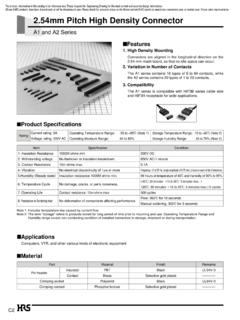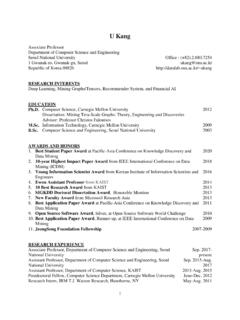Transcription of Antioxidative Properties of Brown Algae Polyphenolics and ...
1 Arch Pharm Res Vol 26, No 4, 286-293, 2003. Antioxidative Properties of Brown Algae Polyphenolics and Their Perspectives as Chemopreventive Agents Against Vascular Risk Factors Keejung Kang , Yongju Park, Hye Jeong Hwang, Seong Ho Kim, Jeong Gu Lee1, and Hyeon-Cheol Shin Laboratory of Aging and Degenerative Diseases, Hanbat National University, Dukmyung-Dong, Yuseong-Gu, Dae- jeon 305-719, Korea and 1 Department of Urology, Korea University, Anam Hospital, 126-1, Anam-dong 5-ka, Sung- buk-ku, Seoul 136-705, Korea (Received January 27, 2003). Several polyphenolic compounds and complex mixtures were isolated from Brown Algae spe- cies. The 1,1-diphenyl-2-picryhydarzyl (DPPH) radical scavenging activity and ferric reducing antioxidant power (FRAP) of these compounds were evaluated to determine their physiologi- cal usefulness as antioxidants for vascular protection. The Antioxidative protection of low-den- sity lipoprotein (LDL) was also evaluated and compared with that of catechin, because the generation of oxidized LDL is one of the most active and specific risk factors contributing to atherogenesis.
2 Oral administration to rats of a commercially available sample (VNPTM) contain- ing 30% of these polyphenolic compounds and 70% dietary fiber revealed that the serum reducing capacity measured in terms of FRAP value was significantly elevated 30 min after the treatment, but declined rather quickly thereafter, indicating the good oral absorption of the compounds and their fast binding to the lumenal surface of the blood vessels. An eight-week, human, clinical trial (n=31) of VNPTM showed significant improvement in erectile function mea- sured by IIEF (international index of erectile function) score. These results collectively demon- strated the usefulness of these polyphenolic compounds as fundamental chemopreventive agents against vascular risk factors originating from oxidative stress. Key words: Brown Algae Polyphenolics , Antioxidative , Oxidized LDL, Endothelial, Vascular protection, Erectile function INTRODUCTION endogenous (from normal metabolism and inflammation).
3 Origin constantly attack endothelial cells, leading to The vascular system, even though it is not generally endothelial dysfunction which breaks the homeostasis of recognized as a separate organ, can be considered as a nitric oxide (NO) level and allows arteriosclerotic progress delocalized organ with numerous tubular branches, a (Harrison, 1997). Subsequent hypercoagulative states of functional capillary area as large as 700 m2, and a blood synergistically aggravate the situation by increasing responsibility for fundamental aspects of every cell in the the blood viscosity. More specifically, oxidative modification body at every minute (Fawcett, 1994). However, the of low-density lipoproteins (LDLs) by ROS is strongly modern lifestyle characterized by a calorie-rich diet, lack involved in the pathogenesis of endothelial dysfunction of physical exercise and mental stress due to excessive (Parthasarathy et al., 1998; Heinecke, 1998; Steinberg, competition constantly puts our blood vessels in a very 1997).
4 Oxidized LDL is known to alter endothelial cell destructive environment (Kris-Etherton, 1999; Massey, functions, thereby modifying their capacity to prevent cell 2001). adhesion and their fibrinolytic Properties . Recent studies Reactive oxygen species (ROS) of either exogenous or have emphasized the role of oxidized LDLs (OxLDLs) in the pathogenesis of atherosclerosis, which is characterized by intimal thickening and lipid accumulation in the arteries Correspondence to: Hyeon-Cheol Shin, Ph. D. Laboratory of Aging (Steinberg, 1997). Endothelial dysfunction or activation and Degenerative Diseases, Hanbat National University, Duk- myung-Dong, Yuseong-Gu, Daejeon 305-719, Korea elicited by OxLDLs is the key step in the initiation of E-mail: atherosclerosis. In response to stimulation by OxLDLs, 286. Antioxidative Properties of Brown Algae Polyphenolics 287. endothelial cells reduce the release of NO, express cardiovascular protection, more specific Antioxidative pro- adhesion molecules, and secrete chemoattractant and tection of LDL by these compounds is also reported since growth factors.
5 Subsequently, OxLDLs are avidly ingested OxLDL has been known as a key risk factor directly by macrophages, resulting in foam cell formation which contributing to atherogenesis. We also describe here the eventually dumps cholesterol inside the arterial wall. in vivo enhancement of reducing ability by oral administra- OxLDLs are also involved in inducing smooth muscle cell tion of these compounds. (SMC) migration, proliferation, and transformation (Ross, Since it is well accepted that deterioration of erectile 1999). function is usually accompanied by vascular degenera- In normal vessels, endothelial cells play a crucial role in tion, erectile function is often termed as a barometer of maintaining vascular homeostasis by neutralizing various cardiovascular health (Caterina, 2000; Azadzoi and risk factors. However, prolonged oxidative stress to these Goldstein, 1992; Azadzoi and Tejada, 1992; Buvat et al., cells exhausts them, leading to endothelial dysfunction 1985).
6 This concept is also supported by the findings at a which often generates a degenerative vicious cycle molecular level that erection occurs by the vasodilation of toward ischemic catastrophe such as heart attack and the penile artery due to large NO release from endothelial stroke (Usui et al., 1999; Wever et al., 1998; Steinbrecher, cells under circumstances of sexual stimulation (Hurt et 1999; Sawamura et al., 1997). al., 2002). Therefore the systemic assessment of erectile Many investigators have found several types of function can be considered as an appropriate and com- antioxidants from leaf, bark, root and fruit of various plant prehensive in vivo indication of general vascular function, species. Recently, as polyphenolic compounds become as well as specifically that of the penile artery. Therefore, known as safe and non-toxic antioxidants, the physiological in this paper, an eight-week human trial of a standardized effects of polyphenolic compounds have been receiving a edible form of Brown - Algae Polyphenolics and the corres- lot of attention as chemopreventive or prophylactic agents ponding improvement of erectile function is also reported to reduce the risk of heart and vascular diseases (Diaz et to provide a future perspective for using these Polyphenolics al.)
7 , 1997). Many epidemiological and in vivo studies have as chemopreventive agents against the risk factors of accumulated evidence showing that these antioxidants vascular diseases. can reduce lipid peroxidation which is involved in atherogenesis, thrombosis, and erectile dysfunction (ED). MATERIALS AND METHODS. Even though many studies have been performed on polyphenolic antioxidants derived from terrestrial plants, All the reagent grade chemicals, purchased from Sigma, only very limited information has been available for such Aldrich and Merck chemical companies, were used without compounds from marine plants (Ng et al., 2000; Deighton further purification. Thin-layer chromatography was performed et al., 2000; Velioglu et al., 1998; Proteggente et al., 2002; on Merck silica gel GF-254 and an RP-18F-254 precoated Pietta et al., 1998; Cao et al., 1996; Burns et al., 2000). plate. Identification was done with UV light and typical The only significant class of polyphenolic compounds TLC indicating solution (p-anisaldehyde/ sulfuric acid/ acetic from marine plants is Phlorotannins or algal polyphenolic acid mixture).
8 Flash column chromatography was performed compounds, which are only known from Brown Algae with Merck silica gel (230-400 mesh). UV spectra (in (Phaeophyta) (Swanson and Druehl, 2002). They have a EtOH) were recorded on an HP 8453 UV spectrophotometer wide range of molecular sizes (400 to 400,000 Da) and and IR spectra were measured on a Bomen MB-100 FT- can occur in variable concentrations ( of the dry IR spectrometer. The NMR spectra were recorded on a weight) in Brown Algae . Phlorotannins are commonly JEOL ECP-500 FT NMR at 500 MHz for 1H and 125 MHz believed to have defensive or protective functions, , for 13C, using TMS as an internal standard. HPLC was against herbivores, bacteria, fungi, fouling organisms and performed on an HP 5980A. FABMS was obtained with a UV-B radiation, and to function in wound healing processes VG Autospec Ultma mass spectrometer. or in cell-wall construction In this paper, we report the application of the 1,1- Pretreatment of Algae material diphenyl-2-picryhydarzyl (DPPH) radical scavenging activity Eisenia bicyclis was freshly collected from Ulung Island, and ferric ion reducing assays to assess the free radical Ecklonia Stolonifera from Kijang, and Ecklonia cava, scavenging capacities and the reducing potentials of the Ecklonia kurome and Hizikia fusiformisfrom Cheju Island, antioxidant constituents of several polyphenolic compounds all in Korea.
9 Their leaves were washed with tap water and mixtures from Brown Algae in comparison with other immediately after collection, air-dried at room temperature well-known antioxidants (Benzie and Strain, 1996; Benzie in a darkened room until a water content of 15-25 wt%. and Szeto, 1999; Schlesier et al., 2002). was reached. The dried Algae leaves were cut into small As well as general Antioxidative protection in support of pieces and kept at -40oC until use. The samples of each 288 K. J. Kang et al. species prepared in this manner Hizikia fusiformis, 1H), (d, J= , 1H), (s, 1H), (d, J= , 1H), Ecklonia kurome, Ecklonia Stolonifera, Eisenia bicyclis (d, J= , 1H), (s, 1H), (s, 1H), (s, and Ecklonia cava, were designated as A1, A2, A3, A4 OH), (s, OH), (s, OH), (s, OH), (s, and A5, respectively. OH), (s, OH), (s, OH), (s, OH), (s, OH);. 13. C-NMR (DMSO-d6, 125 MHz) , , , , Preparation of polyphenolic fraction C1 , , , , , , , , , A1 (100 g) was extracted with boiling water (2 L) for 1h.
10 , , , , , , , , , The resulting solution was dried and milled to yield a , , , , , , , Brown powder (27 g), 10g of which was dispersed to , ; FABMS m/z (M+H)+. distilled water (50 mL) and the soluble portion was C5: white solid; UV(EtOH) max 227 nm; 1H-NMR. subjected to ODS column chromatography with 10% (DMSO-d6, 500 MHz) (d. J= , 1H), (d, J=. methyl alcohol. The eluted solution, which gave a single , 1H), (t, J= , 1H), (t, J= , 1H), broad peak, was collected and evaporated to dryness in a (s, 1H), (s, 1H), (s, 1H), (s, OH), (s, rotary evaporator to give dark Brown solid ( g). OH), (s, OH), (s, OH), (s, OH), (s, OH), (s, OH) ; 13C-NMR (DMSO-d6, 125 MHz) , Preparation of crude samples for polyphenolic , , , , , , , , , compounds C2, C3, C4 and C5 , , , , , , , , A2, A3, A4 and A5 (100 g each) were extracted with , , , , , , , ;. 95% ethanol (1 L) for 2 h in a water bath at 50oC. The FABMS m/z (M+H)+. extraction was repeated twice. The combined ethanolic extracts were evaporated under reduced pressure to give Samples for animal and human a yellowish to dark Brown , gummy-solid and dissolved in VNPTM, a standardized, commercial sample of an edible distilled water.





